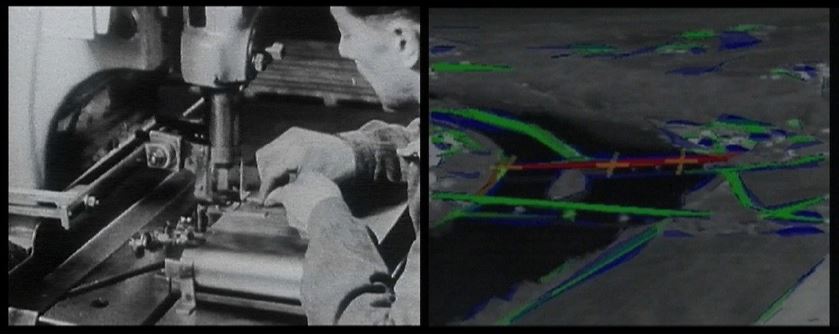Harun Farocki, the video-essay and the use of the conflict imagery.
An approach to the theory of the documentary turn in contemporary art
DOI:
https://doi.org/10.56349/emblecat.251Keywords:
Harun Farocki, video-essay, contemporary art, image, image and politics, image-document, experimental cinema, dialectical montage, military industry, war, simulation, realityAbstract
This paper analyses the work of Harun Farocki (1994-2014) in the context of the documentary turn, exploring how his video-essays question the power of images and their political instrumentalisation through case studies focusing on war conflict. Through critical montage and the use of the video essay, Farocki unveils the structures of surveillance, war and capitalist production, highlighting media manipulation and its effects on collective perception. Case studies such as Inextinguishable Fire (1969), Eye/Machine (2000-2003) and Serious Games (2010) are addressed, where the artist investigates the relationship between technology, representation and reality. His work engages in dialogue with theorists such as Walter Benjamin, Jean-Luc Godard, Hito Steyerl, Georges Didi-Huberman, and Okwui Enwezor, approaching the concept of ‘politics of truth’ in documentary art in the contemporary sphere. Through soft montage and the use of operative images, Farocki reconfigures visual narrative, prompting a critical reading of the power of images in the global age.
Downloads
References
Bibliografía
Agamben, G. (2005), El hombre sin contenido. Áltera.
Badiou, A. (2005), Le Siècle. Éditions du Seuil, París.
Bal, M. (1999), Acts of Memory: Cultural Recall in the Present. Hannover, NH. Darmouth College.
Barthes, R. (1989), La Cámara Lúcida. Nota sobre la fotografía. Paidós Comunicaciones.
Baudrillard, J. (1981), Simulacro y Simulación (The Body in Theory: Histories of Cultural Materialism). Michigan Ed.
Benjamin, W. (1928), Thesen wider Snobisten.
Benjamin, W. (2005), Libro de los pasajes, Madrid, Akal.
Bueno, C. C. (2016), Imágenes operativas y montaje blando: historicidad de la función social de la imagen en la obra de Harun Farocki. Aisthesis.
Deleuze, G. (1987), La imagen-tiempo Estudios sobre cine 2. Paidós Comunicaciones.
Elsaesser, T. (et. al.). (2004), Harun Farocki. Working on the sight-lines. Amsterdam University Press DOI: https://doi.org/10.1515/9789048505265
Enwezor, O. (2003), Documentary/Verité: Bio-Politics, Human Rights, and the Figure of Truth in Contemporary Art. Australian and New Zealand Journal of Art No 4-5. DOI: https://doi.org/10.1080/14434318.2004.11432730
Farocki, H. (2003), Crítica de la mirada. Textos de Harun Farocki. Editorial Altamira, Buenos Aires.
Farocki, H. (2014), Harun Farocki. Diagrams. Images from Ten Films, edited by Benedikt Reichenbach. Editorial Walter König, Köln.
Farocki, H. (2015), Desconfiar de las imágenes. Caja Negra Editora.
Farocki, H. y Silverman, K. (2016), A propósito de Godard. Conversaciones entre Harun Farocki y Kaja Silverman. Caja Negra Ediciones.
Fernández, D. (ed.). (2014), Sobre Harun Farocki. La continuidad de la guerra a través de las imágenes. Ediciones Metales Pesados, Santiago de Chile
Foucault, M., (1975), Vigilar y Castigar, Nacimiento de la prisión. Siglo XXI eds. Argentina.
Foucault, F. (1976), Histoire de la sexualité. Vol. 1. La volonté de savoir. Gillmard, París.
García Martínez, A. (2006), La imagen que piensa. Hacia una definición del ensayo audiovisual. Revista Comunicación y Sociedad. Vol. XIX, No 2.
García-Roldan, A. (2012), El vídeo-ensayo en la formación audiovisual del profesorado. InVisibilidades – Revista Ibero-Americana de Pesquisa em Educação, Cultura e Artes (APEC), Vol. III. DOI: https://doi.org/10.24981/16470508.3.6
Guasch Ferrer, A. (2016), El arte en la era de lo global (1989-2015). Alianza Editorial.
Huberman, D. (2010), Lo que vemos, lo que nos mira. Bordes Manantial.
Recursos web
Bar Laika Presents. Harun Farocki, Parallel III and Parallel IV. E-FLUX. En línea. https://www.e-flux.com/live/255109/harun-farocki-nbsp-parallel-iii-nbsp-and-nbsp-iv/
De Luelmo Jareño, J. M. (2007). La historia al trasluz: Walter Benjamin y el concepto de imagen dialéctica. Dialnet. p. 172-174.
https://dialnet.unirioja.es/servlet/articulo?codigo=2688858
Didi-Huberman, G. (2009). How to Open Your Eyes. MIT Press. p. 44. En línea.
https://monoskop.org/images/b/bf/Didi-Huberman_Georges_2009_How_to_Open_Your_Eyes.pdf
Galería Àngels Barcelona.
http://angelsbarcelona.com/en/artists/harun-farocki/projects/serious-games/242
Steyerl, H. (2003). Politics of the Truth. Documentarism in the Art Field.
https://www.springerin.at/en/2003/3/politik-der-wahrheit/
Zoller Sietz, M. (2014). Harun Farocki, 1944-2014: His Inextinguishable Fire. Roger Ebert. https://www.rogerebert.com/mzs/harun-farocki-1944-2014-his-inextinguishable-fire
Artículo de la revista Artishock, “Harun Farocki, desconfiar de las imágenes”.
https://artishockrevista.com/2015/06/05/harun-farocki-desconfiar-las-colección/
Museo Nacional Centro de Arte Reina Sofía de Madrid.
Descripciones de Harun Farocki acerca sus series.

Downloads
Published
How to Cite
Issue
Section
License
Copyright (c) 2025 EMBLECAT, Estudis de la Imatge, Art i Societat

This work is licensed under a Creative Commons Attribution-NonCommercial-NoDerivatives 4.0 International License.




